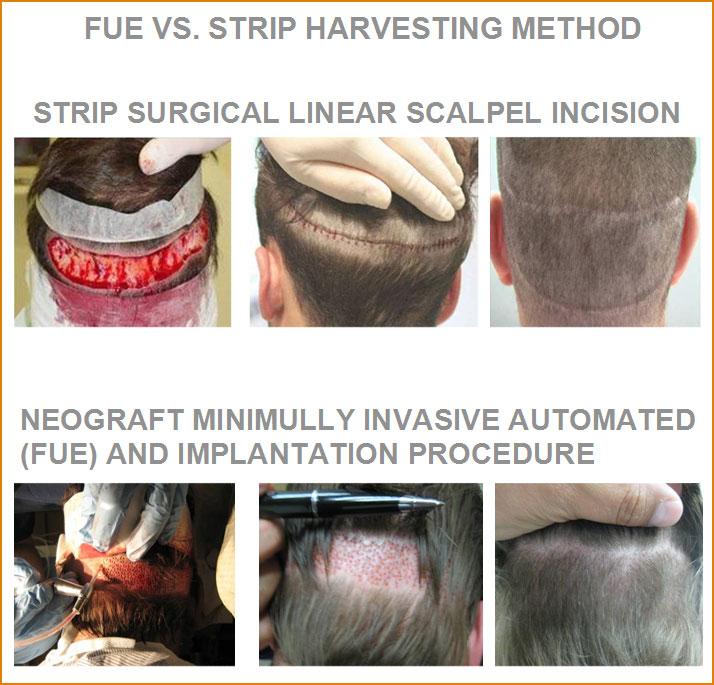1) Understanding the Distinction: Hair plugs and hair implants are two common procedures for hair restoration, but they function differently. Hair plugs involve taking small portions of hair-bearing skin and moving them to areas with hair loss, while implants involve individually implanting hair follicles into the scalp.
When it comes to choosing a procedure for hair restoration, it’s crucial to comprehend the differences between hair plugs and implants. Hair plugs entail transplanting small sections of skin that contain hair, while implants require microsurgical follicle implantation. In terms of appearance, results from hair plugs may appear pluggy and unnatural, whereas implants create a more natural-looking outcome.
Natural Outcomes: A significant distinction between these two methods is the naturalness of their outcomes. Implants oftentimes produce a more natural look and feel due to individual placement that mimics natural growth patterns. On the other hand, because of how they are inserted into the scalp, results from traditional plugs can seem unnatural.
The aesthetic benefits go beyond appearance as well. Natural-looking results provide practical advantages including greater styling options without visible signs of a procedure on individuals who opt for implant treatment.
Scarring: While both processes differ significantly in their scarring outcomes as well. Hair plug procedures have been known to leave noticeable scarring due to larger incisions made during their removal process compared with smaller ones accompanied by an individual placement process in follicle implants which usually result in minimal scarring.
understanding these distinctions is important when considering any type of treatment option for your specific needs It will help you make an informed decision about selecting either method depending on your desired outcomes!Hair plugs and hair implants are two popular options for individuals seeking hair restoration procedures, but the scarring caused by hair plugs can be a major concern. The visibility of scarring can have a significant impact on the overall aesthetic and natural look of the hairline. On the other hand, hair implants offer minimal scarring, making them a more appealing option for those looking for a less invasive and discreet procedure.
Recovery Time:
Hair restoration procedures vary in terms of recovery time, with hair implants generally having a shorter healing period compared to hair plugs. This is due to the smaller incisions and individual placement of follicles, which promote quicker healing. The faster healing process with implants means less downtime and reduced discomfort during recovery.
Cost:
When it comes to the cost of these procedures, initial investment in hair plugs may seem cheaper at first glance. However, over time, implants can be more cost-effective as they offer long-term results without requiring ongoing maintenance or touch-ups. Additionally, minimal scarring means there is less need for additional procedures to correct any visible scarring.
Meta Title: Enhance Your Hair: Deciding Between Plugs and Implants for Restoration
Meta Description: Learn about the differences between hair plugs and hair implants and find out which option is best for restoring your hair. We’ll cover the benefits, practical tips, and more to help you make an informed decision.
Header 1: Enhance Your Hair: Deciding Between Plugs and Implants for Restoration
Are you struggling with hair loss or thinning hair? There are numerous options available for restoring your hair, but two of the most common methods are hair plugs and hair implants. If you’re considering hair restoration, it’s important to understand the differences between these two techniques and determine which one is best for you. In this article, we’ll explore the benefits, practical tips, and provide valuable information to help you make an informed decision.
Header 2: What Are Hair Plugs?
Hair plugs, also known as hair grafts, are a traditional method of hair restoration that involves transplanting small sections of scalp containing hair follicles from the back or sides of the head to the balding areas. The plugs typically contain between 10 to 20 hairs and are implanted into the scalp, creating a fuller, thicker hairline.
As with any surgical procedure, there are potential risks and drawbacks to consider with hair plugs. These include the possibility of scarring, an unnatural appearance if not performed correctly, and a longer recovery time. While hair plugs have been a popular method of hair restoration for many years, they may not be the most advanced or effective option available today.
Header 3: What Are Hair Implants?
Hair implants, also known as hair transplantation, have become a popular and highly effective method of hair restoration in recent years. This advanced technique involves removing individual hair follicles from the back or sides of the head, where hair is usually thicker and less prone to balding, and transplanting them to the thinning or balding areas.
The main advantage of hair implants is the natural-looking results they can achieve, as the individual hair follicles are meticulously placed to match the natural growth pattern of your hair. Hair implants also have a shorter recovery time and typically result in minimal scarring, making them a preferred choice for many individuals seeking hair restoration.
Header 2: Benefits of Hair Implants vs. Plugs
When comparing hair implants to plugs, there are several key benefits to consider:
- Natural Appearance: Hair implants produce a much more natural appearance, as individual hair follicles are transplanted to mimic the natural
Consult with a Professional:
Ultimately, it is important to consult with a qualified hair restoration professional when deciding between hair plugs and implants. They can assess your specific needs and recommend the best option for your individual situation.
In conclusion
The decision between these two options should take into account factors such as potential scarring visibility during recovery time and long-term costs before proceeding with any procedure. Consulting with professionals will provide you better guidance based on your individual needs when considering either method of restoring your natural appearance aesthetically pleasingly while promoting faster healing throughout after-effects in fewer durations than initially planned or ongoing expectations from surgical treatments offered by various specialists worldwide today!The Importance of Consulting a Professional for Hair Restoration Decisions
When faced with the choice between hair plugs and implants, it can be overwhelming to make the right decision. Seeking advice from a professional in the field of hair restoration is crucial to ensure that you are well-informed and make the best decision for your specific needs. Here are several reasons why consulting with a professional is essential:
Personalized Assessment: A qualified hair restoration professional can evaluate your particular needs, taking into consideration factors such as hair type, pattern of hair loss, and overall scalp health. This personalized assessment allows them to recommend the best option for you.
Professional Guidance: Hair restoration professionals have the knowledge and expertise to guide you through the decision-making process. They can address any concerns or questions you may have about hair plugs versus implants.
Long-term Results: Consulting with a professional ensures that you receive a customized treatment plan designed to provide long-term, natural-looking results based on your unique situation. This tailored approach can lead to greater satisfaction with both the chosen procedure and its overall outcome.
In Retrospect
To make an informed decision about which hair restoration method is right for you – whether traditional plugs or newer implants – it’s important to consider both the pros and cons. It’s essential to consult with a qualified professional who can help you find the best option for your individual needs. Ultimately, regaining confidence in your appearance is key when considering any form of hair restoration procedure. Good luck on your journey toward achieving your desired results!


